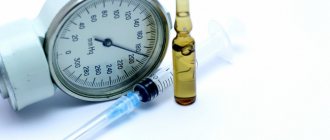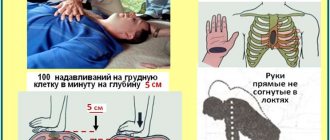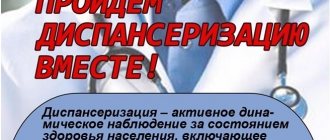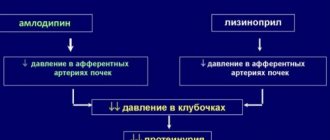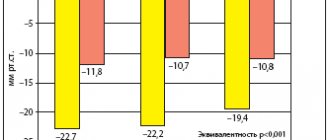Hypertensive crisis
is one of the most dangerous complications of arterial hypertension (hypertension).
It develops in approximately 15% of patients with arterial hypertension. The duration of a hypertensive crisis
can range from several hours to several days.
At the same time, the symptoms of existing hypertension intensify and become more pronounced. For every patient with hypertension
you should know about the likelihood of
a hypertensive crisis
, its signs and your actions in this condition.
Symptoms of hypertensive crisis
- A sharp increase in blood pressure to 220/120 mm Hg. Art. and higher.
- Headache, dizziness, tinnitus, black spots flashing before the eyes.
- Dyspnea.
- Nausea, vomiting.
- Chest pain.
- Neurological disorders (convulsions, impaired consciousness, paralysis).
A hypertensive crisis may be accompanied by a feeling of fear, trembling, chills, redness of the facial skin, swelling of the face, and blurred vision. Particular danger of hypertensive crisis
Represents for patients suffering from any diseases of the brain and heart.
Diagnostics
If you follow the recommendations of the World Health Organization, then all patients with suspected TIA should be taken to a regional vascular center. The speed of the examination (within 24 hours) will significantly increase the chances of finding out the picture of general changes. The list of procedures includes:
- conducting MRI using diffusion-weighted images and gradient T2-weighted images;
- A CT scan is performed if it is not possible to do an MRI;
- ultrasound examination of the vessels of the head and neck if there is a suspicion of a stroke;
- clinical examination of physiological parameters with blood tests;
- conducting an ECG.
Additional procedures include:
- echocardiography;
- checking blood for clotting;
- biochemical blood tests.
The diagnostic criteria for transient ischemic attack are based on the ABCD2 scale, which is widely used in Western Europe and the USA.
It can be used to predict the risk of stroke in patients who have suffered a TIA. The assessment school looks like this:
- A - blood pressure indicators;
- B — patient’s age (over 60 years);
- C — symptoms of the disease (general list of ailments);
- D—duration of symptoms and history of diabetes.
This approach allows for an objective assessment of both mild and more severe manifestations of ischemia.
A complete examination of the patient will allow differentiation of TIA from other diseases, such as:
- Neurological disorders: migraines, focal seizures, brain tumor, subdural hematoma, hemorrhage, multiple sclerosis, myasthenia gravis, paralysis and narcolepsy.
- Somatic and mental disorders: hypoglycemia, Meniere's disease, vestibular neuritis, syncope, orthostatic hypotension, hysteria, psychosomatic abnormalities.
There is a range of significant signs with the help of which we can more likely speak about the correct differentiation of acute VBD from other diseases. These include:
- rotational dizziness;
- degree of feeling of unsteadiness or stability in an upright position;
- balance problems;
- the presence of cystic-glial changes in the head;
- the presence of atherosclerosis of the brachiocephalic arteries with stenosis exceeding 50%.
TIA is characterized by the presence of several signs, so the patient’s condition requires a qualitative analysis.
Forms of hypertensive crisis
Cerebral angiohypotonic crisis with clinical manifestations of hypertensive encephalopathy
The most common form of hypertensive crisis. The reason is an excessive increase in cerebral blood flow and relaxation of cerebral vessels. The patient feels a pressing headache, a feeling of fear, dizziness, lethargy. Blood pressure may rise to 170/110 mmHg. This type of hypertensive crisis
often accompanied by vomiting.
Cerebral ischemic crisis
Less common form, but most dangerous. Blood pressure reaches higher numbers - 220/120 mmHg. The patient experiences general symptoms of cerebrovascular disease - dizziness, headache, neurological disorders - numbness of the face or limbs, impaired coordination of movements, short-term blindness or muteness. Cerebral ischemic crisis is a prerequisite for the development of cerebral stroke.
Hypertensive cardiac crisis
A hypertensive cardiac crisis by high blood pressure numbers. The patient experiences shortness of breath, chest pain, rapid heartbeat, and complains of a dry cough. Hypertensive cardiac crisis can cause myocardial infarction.
Diagnostic measures
If the above-described complaints occur, a person should immediately make an appointment with a professional therapist, a specialist in neurology or cardiology. The necessary instrumental tests are performed only after first aid has been provided to the patient and are required for an in-depth check of the state of blood circulation in the brain, as well as the cardiovascular structure. The most common medical procedures for HCC are:
ECG.- Daily blood pressure monitoring.
- Rheoencephalographic study.
- ECHO-EG.
- EEG.
- Ultrasound Doppler.
- Consultation with an ophthalmologist.
- Ophthalmoscopic examinations.
- Perimetric diagnostics.
- MRI scan.
Complications of hypertensive crisis
A hypertensive crisis is dangerous not so much in itself as the influence of high blood pressure on target organs - in the first place. Disruption of blood microcirculation in the brain leads to swelling (hypertensive encephalopathy).
During an increase in blood pressure, the walls of the blood vessels in the brain experience enormous stress, which can lead to hemorrhage in the brain (hemorrhagic stroke).
A sharp increase in blood pressure also affects the function of the heart, not excluding the possibility of angina pectoris - an acute lack of blood supply to the heart muscle with the development of acute heart failure, expressed in the form of shortness of breath, suffocation, and pulmonary edema. The most severe complications of hypertensive crisis
are heart attack and stroke.
Severity criteria
There are 3 degrees of severity of TIA. They indicate the positive or negative dynamics of the disease:
- mild degree - lasts approximately 10 minutes, focal symptoms that disappear without consequences;
- moderate degree - lasts from 10 minutes or more, the attack occurs without consequences for the patient’s health;
- severe - transient cerebral ischemic attack is prolonged, and neurological signs worsen.
According to ICD-10, transient ischemic attack has a standard classification:
- TIA in the VBB (vertebrobasilar area);
- TIA in the carotid region;
- TIAs are multiple or bilateral;
- transitional blindness syndrome;
- TGA (transient global amnesia);
- unspecified TIA.
The type and severity of local decrease in blood circulation in the head can only be determined by a qualified medical professional.
Make an appointment
First pre-hospital emergency medical care for hypertensive crisis
Hypertensive crisis is a condition that requires urgent measures, because delay can lead to even more severe complications and death. The patient needs to clearly remember the simple rules of independent first aid and not get confused at the right moment.
Independent pre-medical emergency care primarily consists of taking the antihypertensive drugs used (Corinfar, captopril, nitroglycerin, furosemide, etc.) prescribed by the doctor.
During a hypertensive crisis, you need to try not to panic, relax and restore your breathing by taking a series of inhalations and exhalations several times. If an attack overtakes you at home, your loved ones can provide invaluable help: put mustard plasters on your calves, help you take warm foot baths (temperature 30-40 °C, duration of treatment - 10-15 minutes). The measures taken in no case cancel the call to the doctor, because only allow you to stop a hypertensive crisis
rather than eliminating its consequences.
It must be remembered that the main means of preventing hypertensive crises remains the main task - the treatment of arterial hypertension. Do not delay treatment for arterial hypertension
for tomorrow!
GUTA CLINIC specialists will individually select for you the most modern, effective, safe antihypertensive drugs in adequate dosage to achieve the best therapeutic effect, and will also prescribe a set of measures aimed at eliminating risk factors for high blood pressure.
How to get rid of it?
If the second and third forms of anomaly are detected, the patient is urgently hospitalized at the nearest medical center. The likelihood of inpatient therapy for the first stage of the disease depends on its severity. One way or another, the presented illness requires complex treatment measures, which will consist of general antihypertensive and tranquilizing techniques (diazepam, phenazepam, etc.).
The doctor prescribes symptomatic treatment and vasoactive components, selected according to the type of cerebral crisis (ß-blockers, ACE inhibitors). Drugs are administered by intravenous drip or jet. The patient will need to adhere to bed rest until blood pressure returns to normal and neurological problems resolve.
Treatment
The most important thing is to provide the victim with appropriate assistance in a timely manner, since it is difficult to make a diagnosis at first glance. You should know that emergency care is available. This is a series of specific actions aimed at stabilizing the patient’s condition and hospitalization:
- calling an ambulance;
- control of breathing, heart rate and blood pressure;
- relief of convulsive syndrome.
The victim should be given the opportunity to breathe freely: loosen his tie or unbutton the top buttons of his clothes, open the window.
Be sure to take a horizontal or half-sitting position. If vomiting occurs, clear the airways. The patient can be given a small amount of water. The goal of TIA therapy is to prevent subsequent attacks with the development of complications. First of all, the decrease in blood supply is stopped, followed by restoration. Doctors select treatment based on the underlying disease: diabetes mellitus, arterial hypertension, thromboembolism or other pathologies.
The duration of treatment depends on the specific case. The patient can undergo the recovery period on an outpatient basis or in a clinic. He may be prescribed:
- infusion therapy, when Reopoliglucin or Pentoxifylline is injected drip into a vein;
- antiplatelet agents: acetylsalicylic acid, Clopidogrel, which prevent the formation of blood clots;
- anticoagulants: Clexane, Fraxiparine. They require monitoring of blood counts;
- neuroprotectors: Magnesium sulfate, Ceraxon, Actovegin. With their help, nerve cells receive appropriate protection from oxygen starvation;
- nootropics: Cerebrolysin, Piracetam;
- statins: Atoris, Vaseline - help lower the concentration of cholesterol in the blood;
- antiarrhythmic drugs are prescribed for heart rhythm disturbances;
- antihypertensive agents: Lopril.
According to indications, symptomatic treatment can be carried out, which is prescribed individually.
A patient experiencing a transient ischemic attack is strictly prohibited from sharply lowering blood pressure; it is preferable to maintain it at a slightly elevated level.
The attending physician may prescribe physiotherapeutic procedures, including:
- Oxygen barotherapy is a treatment with an air environment with a high oxygen content, which promotes cell regeneration.
- Electrosleep is therapeutic; it allows subcortical connections to be restored through exposure to a safe pulsed current.
- Electrophoresis - the effect of current pulses in combination with the administration of drugs.
- DDT (diadynamic therapy) is one of the methods of electrotherapy, when the patient’s body is exposed to Bernard currents. They have low frequency and voltage.
- SMT is the effect of sinusoidal currents on biological tissues. They have a beneficial effect on the entire body.
- Microwaves - human tissues and organs are affected by a specially created electromagnetic field, its wavelength is 12.6 cm, and its frequency is 2375 MHz.
- A circular shower is a useful hydroprocedure; its principle is the needle-like effect of streams of water on the human body over the entire surface. The water from such a shower envelops the entire body. The procedure takes place in a special box, which is equipped with a large number of tubes, from which water is supplied.
- Therapeutic baths (pine, radon, pearl).
According to indications, massage procedures aimed at improving blood circulation can be used. Surgical intervention is prescribed for atherosclerotic lesions of extracranial vessels. This procedure has 3 varieties:
- carotid endarterectomy - removal of atherosclerotic plaque located inside the vessel;
- arterial stenting - the procedure is performed on narrowed arteries;
- prosthetics - the affected area of the artery is removed and replaced with a graft.
A patient suffering from a TIA requires professional advice from appropriate specialists. Treatment after a transient ischemic attack will depend on the cause of the attack, frequency and age of the patient. If the symptoms are mild and attacks are sporadic, then recovery is quick.
